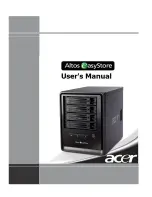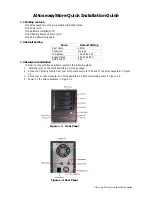
EonStor S12F-R1432/G1433 Installation and Hardware Reference Manual
WARNING!
All Fibre cables are sensitive and must be handled with care. To
prevent interference within a rack system, the cable routing path
must be carefully planned and the cables must not be bent.
3.1.2 FC
Lasers
CAUTION!
Lasers can be hazardous and may cause permanent eye damage
or blindness, and therefore must be treated and used with caution.
Never look at lasers without confirming that they are off.
Wavelengths:
The lasers on fibre optic cables emit either short wave
(SW) beams (770nm-860nm) or long wave (LW) (1270nm-1355nm)
beams. Cables using either of these wavelengths can be used.
Laser types:
Two (2) types of laser devices can be used in FC
cables: Optical Fibre Control (OFC) and non-OFC lasers. The OFC
lasers are high-powered and can be used over long distances.
Safety features:
Due to their high power output, OFC lasers usually
come with a safety mechanism that switches the laser off as soon as
it is unplugged. Non-OFC lasers are low power and do not come with
these safety features; however, they can still inflict damage.
3.1.3
FC Speed Auto-detection
Speed auto-detection is specified by the Fibre Channel standard. If a
2Gbps port is connected to a 4Gbps port, it will negotiate down and
run at 2Gbps. If there are 4Gbps ports on both ends of the link, the
link will run at 4Gbps.
3.1.4 SFP
Transceivers
Once you have purchased your FC cables, it may be necessary to
connect them to SFP transceivers. These transceivers should
typically have at least 4Gbps bi-directional data links, a laser
transmitter (for fiber optic cables), LC connector, and a metal
enclosure to lower the EMI. The system supports using SFP
transceivers on fibre optic cables emitting short wave (SW) beams.
NOTE:
LC connectors are small form-factor, fibre-optic connectors based
on a 1.25-mm ceramic ferrule with the familiar latching mechanism
of the RJ-45 modular plug and jack.
3-2
















































